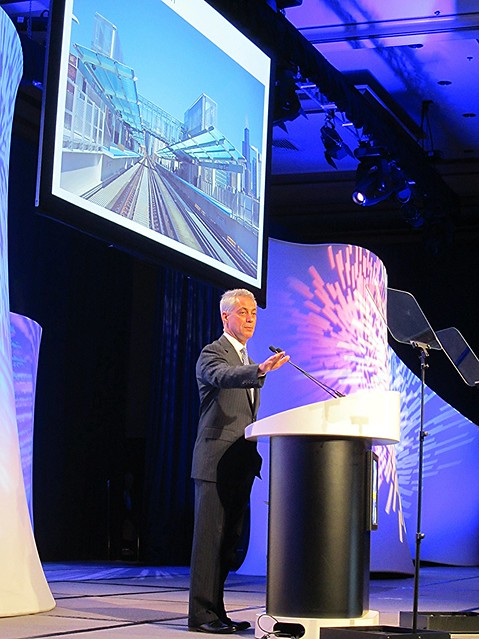In his keynote address for the American Public Transportation Association’s annual meeting yesterday at the Hilton, Mayor Rahm Emanuel said that quality transit is a cornerstone of his economic development policy.
CTA President Forrest Claypool warmed up the crowd before the mayor arrived. Speaking on the eve on the federal government shutdown, Claypool noted that better public transportation used to be a goal that Republicans and Democrats worked towards together. “Transit has always been one of those areas where previously there seemed to be bipartisan consensus because there was a fundamental understanding of Economics 101 which seems to now have disappeared,” Claypool said. “Back in 2006, [House Speaker Dennis] Hastert, Mayor Emanuel, Congressman [Bill] Lipinski and others worked together to find funding to rebuild the Brown Line.”
Fortunately, the federal government, the state and the city worked together to rebuild the Brown Line and now it’s one of the fastest growing lines in the city, Clypool said. “There’s also been a remarkable impact on economic development along that rebuilt corridor,” he said. “Something like a quarter of all building permits since 2007 have been within half a mile of the Brown Line. That’s a remarkable example of the impact of economic development: if you build it, they will come.”
After a few minutes, Emanuel took the stage to the strains of “Chicago (That Toddlin’ Town)” and a standing ovation. The mayor began by mentioning he took the CTA downtown that morning, as he often does, although his late arrival, as well as a Blue Line crash that morning in Forest Park, which injured 33 people, didn’t reflect particularly well on the system.
“I see public transportation as a core piece of our economic strategy as a city,” he said. “We have a three-part strategy. One is modernizing our airport. Two is modernizing our public transportation system. Third is, obviously, modernizing our roads, but also our bike network.”
Emanuel noted that the CTA is adding or rebuilding six new stations throughout the city, and 100 stations have either been refurbished or rebuilt during his administration. “Today we announced a new station at Washington-Wabash, which I call The Gateway,” he said. “It’s the first new downtown station since the Harold Washington Library stop, so for two decades, and it’s the first megastation in the city.” He added that a new Green Line station is also planned on Cermak near McCormick Place, and the Wilson, Loyola, Clark/Division and 95th Street stops are being rebuilt.
“The Red Line on the South Side opened in 1969,” he said. “It has not really been refurbished in all that time, since we were putting a man on the moon… There were times in the city there were so many slow zones that, funny but sad, people on bikes were passing the train. When we started rehabbing the Red Line this summer, people were arriving to work faster taking the buses then they usually do taking the train, by an average of 20 minutes. That’s how bad it had debilitated as a system.”
The mayor mentioned the attractive new Morgan Green Line stop as an example of how station construction gives a boost to economic development. “Prior to opening it, there were three real estate deals in that area,” he said. “Since opening it there have been 43 commercial real estate deals in that area. The prices in that area have jumped nearly 50 percent in value. Rental prices are up 25 percent. Google is thinking about moving their sales office to that area. Four new hotels have opened up, restaurants have opened up… And property values within a half mile of a new station are 50 percent greater than property values that are outside that half-mile zone.” He also touted the ability of transit construction to create jobs, noting that 5,000 people are now at work on station projects and the Red Line rehab.
He argued that the south Red Line renovation has been a resounding success. “We’re three weeks away from opening it, ten-and-a-half miles, five stations, totally rebuilt, saving $75 million over the other plan of doing it over four years every weekend, rather than doing it every week,” he said. “And to the great credit of the commuters, they have suffered through it. They’re going to get a whole new system, and it will be on time and on budget.”
Emanuel noted that the CTA is pioneering the Ventra farecard system, the first one in the country to allow customers to use their existing bank card as a farecard. “In the last month, 25 percent of the rides have been on the Ventra card including the mayor’s ride this morning,” he said. “It’s perfectly seamless and conflict-free.” That may be a bit optimistic, since there have been multiple reports of glitches in the system’s first weeks.
The mayor concluded by putting the recent system improvements in historical context. “Many of the stations we’ve rebuilt or rehabbed or refurbished were first online in 1909, when Teddy Roosevelt was president and the Chicago Cubs won their last World Series," he said to laughter from the audience. "You laugh, that’s painful. But that’s the kind of work that had been delayed, deferred and denied, which actually held the city back. We’re finally moving into the 21st Century aggressively.”

![1b - Center of Tracks (Night) LOW RES[2] - lighter sky copy(1)](http://farm6.staticflickr.com/5458/10042185603_a1061bb244_z.jpg)




